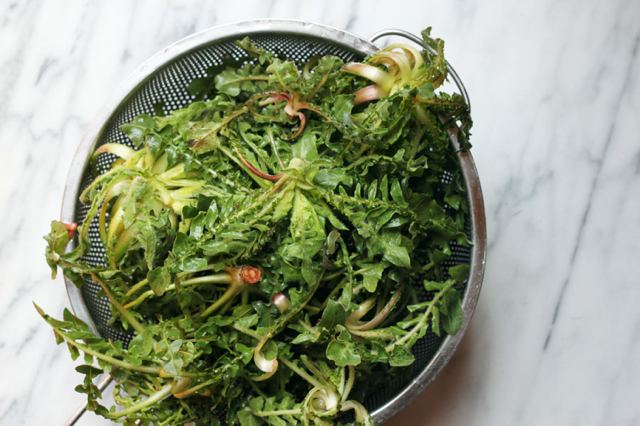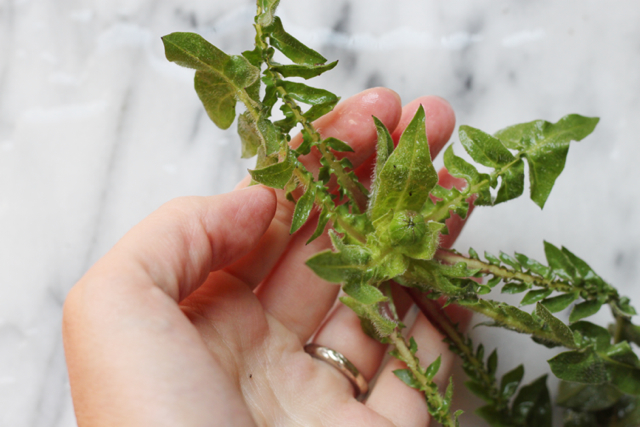A surprise find at one of my favourite markets in Florence last week led me to this beautiful and ancient dish, acquacotta (literally, “cooked water” but also meaning “cooked in water”), a tradition of southern Tuscany and Lazio, where the fields are filled with mounds of curly, jagged-edged weeds and other wild vegetables and greens that I had never seen and certainly never cooked with before.


There’s something about eating wild vegetables – so far flung from their modern, cultivated versions, so earthy and wonderfully bitter. Bitterness is an underrated gastronomic experience in Anglo-Saxon cuisines, where it is generally seen as a negative and harsh flavour. But it’s a flavour that is appreciated by Mediterranean palates and apparently also happens to indicate high levels of nutrients – it makes me think of this very interesting article on how, over the centuries, we’ve bred the nutrients out of our fruit and vegetables in favour of sweeter tasting produce.
Wild vegetables and herbs retain the flavour they had in centuries past, unadulterated and unchanged. Acquacotta is a dish that is probably closer than anything you can imagine to the flavours that distant ancestors might have eaten.

It was once a meal that was thrown together outdoors, over a boiling pot made by butteri (Maremman cowboys), shepherds or fisherman, wherever they happened to be. Along with a pot of water, some dried bread (even bread that was specifically made and dried to be easily portable for making this dish), garlic and wild herbs and greens that were foraged from around the fields during the spring and autumn – calamint, wild chicory, stinging nettles, dandelions, sow thistle, wild beet, wild fennel, wild asparagus or whatever else could be collected. Fishermen would add some small fish from their catch.
It was also a dish made often at home and in this case, usually potato or tomatoes were added. And if it was a special occasion (or if you were just lucky), the acquacotta was completed with an egg, cracked right into the soup itself to poach, or perhaps a piece of baccalà.

The characteristic of this dish, at least in the way they do it in Viterbo, is that the vegetables and aromatics are cooked entirely in water, not sizzled in olive oil. And in any case, the classic soffritto is usually forgone for just some garlic cloves, whole and unpeeled, that go straight into the water. To serve the acquacotta, the vegetables and accompanying broth are then spooned over a slice of dried or stale bread, which soaks up any liquid. The resulting dish should not be brothy at all, in fact, any liquid that remains in the bottom of the bowl should be removed as it would interfere with the final touch – some extra virgin olive oil, drizzled over the top.
It’s a wonderfully simple dish of clean flavours where the strong, bitter flavours of the wild chicory sing out in contrast to the creamy, mellow egg yolk and bitey, raw olive oil.
I also love the sound of this Acquacotta from southern Tuscany by one of my favourite food bloggers – it’s quite a different recipe all together but you can see they are distant cousins.

Acquacotta Viterbese
- 2 large bunches of wild chicory
- garlic cloves
- 2 small potatoes, peeled and thinly sliced
- 300 grams of tomatoes (roma are best), chopped
- pinch of salt
- 4 eggs
- 4 slices of stale bread from a good, dense, wood fired country loaf (or if fresh, dry out the slices in a low oven)
- extra virgin olive oil
- a handful of chopped, wild fennel and calamint (if unavailable, use fennel tops in place of the wine fennel and oregano, marjoram or mint in place of the calamint)
Carefully wash the wild greens several times over or until all the dirt has been removed. If they are tough or large, you may need to blanch them first until tender. If they are young and small then just use them as they are.
Place the garlic cloves, potatoes, tomatoes, the wild greens and salt in a pot and add water to cover. Bring to a simmer and cook until the vegetables are tender. Crack the eggs into the simmering soup and cover until the whites are cooked but the yolk still runny, a few minutes. Remove from the heat, place a slice of bread in each shallow bowl and ladle the soup and egg over each slice of bread. Let rest a minute or two so that the bread can soak up the broth. Ideally, the bread should soak everything up and there should be no liquid in the bowl. If the bread hasn’t soaked up enough, be sure to ladle over some extra broth from the pot. If there is any extra liquid present in the bowl, remove it with a spoon or kitchen paper.
Finish with a drizzle of very good olive oil and a generous handful of chopped wild fennel and calamint.




Comments
….and I love the sound of this acquacotta. I think this dish sums up so much about Italian cooking, the ingenuity, the simplicity, the endless variations from kitchen to kitchen, town to town, the downright goodness of it all. Beautiful pictures as always, see you soon (hurrah) Rx
This looks fantastic. I have sorrel in my garden, I wonder if I could use it in this recipe?
this looks pretty and delicious!!! The Saxons loved bitter herbs, there was an eggy dish called a Tansy that was a big favourite – named after the Tansy herb, a bitter green herb. I haven’t found Tansy yet, I will have to grow it to use it.
Hi,
I live in Florence and am wondering what exactly was your surprise market find (was it the wild chicory?), and in which market did you find it? I’m curious! Thanks!
Yes, it was the wild chicory, but also wild fennel and a few other wild foraged things like cime di rapa and asparagus. A young guy who forages them from around Pistoia sells his vegetables (and these when they are around!) in Piazza Santo Spirito – he’s there Wednesdays and Fridays, just in morning of course 😉
What a lovely, interesting post. It is so true that we still eat that way here in Italy, but reading your words brought me to a time long before I was born and had me daydreaming a bit.
Thanks, am so glad to hear this! 😉